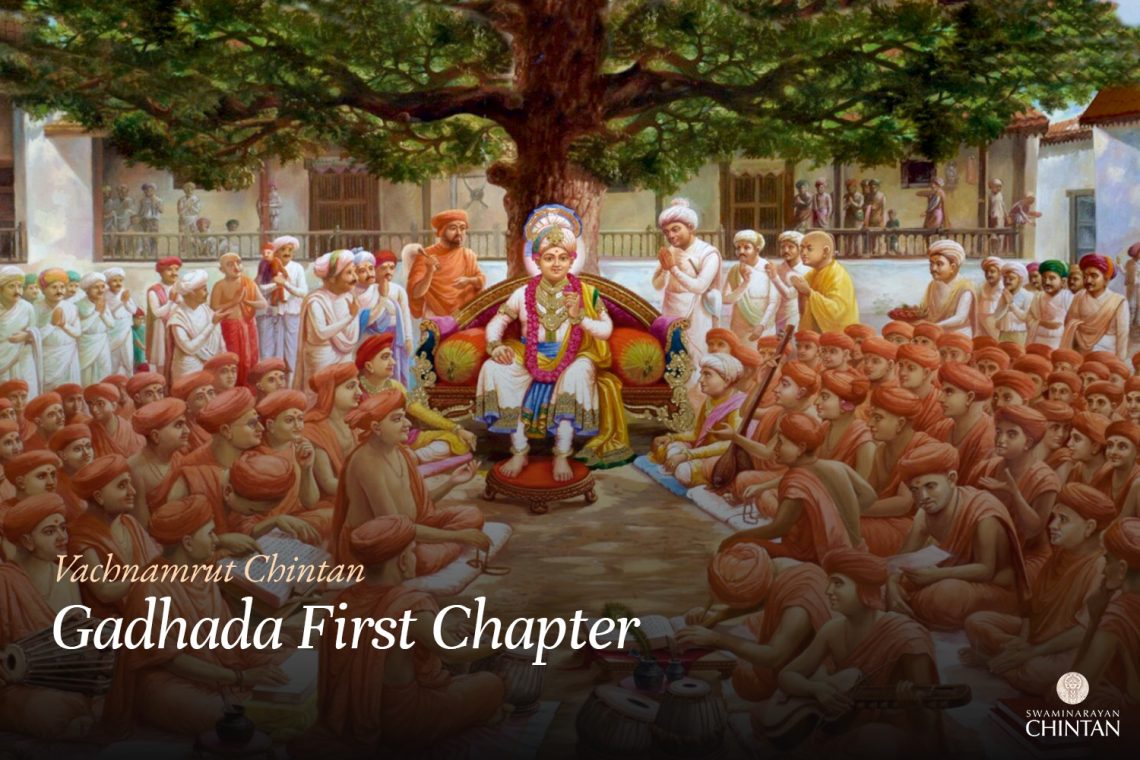Central Insights:
- Characteristics of Devotees with Four Different Propensities.
Key Points:
- Those who exhibit a particular propensity in life, suitable for progress in Satsang, are called “Ang” (propensities).
- If the propensity is unclear, progress is hindered.
- One must strengthen the primary propensity.
- Eventually, all four propensities should be developed.
Explanation
This Vachanamrut discusses the propensities of devotees of the God. First and foremost, understanding what a propensity is will be beneficial. Each individual lives their life in a unique manner. In Satsang, everyone aims for spiritual progress, and each person has a distinct path to follow. These different paths are referred to as propensities. For instance, there are those inclined towards service, devotion, singing devotional songs, and other such propensities. If someone is inclined towards worldly matters, such as desires and anger, they are said to have a worldly propensity. Thus, during Satsang, one must recognize their particular propensity. It may be the propensity for service, devotion, or other aspects.
Maharaj has emphasized that before Satsang, one may possess a worldly propensity, but upon entering Satsang, they acquire a spiritual propensity. This shift towards a spiritual propensity is more favorable. Each propensity has its significance, such as service, devotion, and others. So, when one is inclined towards spiritual virtues, they are said to have a spiritual propensity. This transition occurs in Satsang, where they begin to incline towards virtues such as service, devotion, and others. Afterward, they strive to strengthen these propensities. For example, they may focus on self-realization, devotion, or other aspects. The goal is to develop all four propensities.
When Maharaj speaks of strengthening a particular propensity, he refers to the specific scriptures and practices associated with that propensity. For instance, if one is inclined towards Vairagya (renunciation/detachment), they should read texts like “Nishkulanand Kavya.” If they are inclined towards Gyan (knowledge), they should study the Vachanamrut and the Bhagavad Gita. If they are inclined towards Dharma, they should immerse themselves in the life of Satsang and read the Smriti scriptures. If they are inclined towards Bhakti (devotion), they should read Bhaktachintamani, Bhagavat, and stories of God.
From this, one can also identify their own propensity. If we find ourselves drawn towards someone’s company, whether it’s an elder or a younger devotee, then that propensity also becomes a part of our being. So, if we are fortunate enough to develop such an inclination, we can recognize it in this way.
When our minds are not inclined towards any other favorable activities then, whatever type of spiritual inclination arises naturally in our leisure time, that becomes an integral part of our being. In other words, during such times, if there is an inclination towards devotion, studying scriptures, and similar interests, then it becomes a part of our spiritual practice. If one has an interest in Dharma – religious rituals, then that becomes a part of their spirituality. If someone is inclined to delve into spiritual texts, then they become a part of the pursuit of knowledge. When the sparks of renunciation awaken within, it becomes a part of detachment. These can all be determined. If, during these practices, we still find it difficult to decide one’s propensity, then we can pray to God and select anyone which comes to mind, Dahma or Gayan or Vairagya or Bhakti, then stick to it and make efforts in achieving the selected one.
Now, let us return to the original Vachanamrut. Here, Maharaj has described four key aspects. He also states that, to some extent, all devotees naturally possess these forms of nishtha (firm faith). This makes it quite difficult to determine distinctions. Therefore, by delving deeper into these aspects, we can gain a clearer understanding.
In literature, there are nine rasas (emotional flavors), such as Shringar (romantic), Veer (heroic), Shanti (peaceful), and so on. Each rasa has a corresponding sthayibhava (dominant emotion). For example, in Shringar rasa, it is Rati (affection); in Veer rasa, it is Utsaha (enthusiasm); and in Shanti rasa, it is Nirveda (detachment). These sthayibhavas exist within every individual in seed form. They need to be stimulated and nurtured through uddipana (excitement), alambana (support), and other means, which then bring them to the surface. Only then does a person fully experience Shringar, Veer, Shanti, and the other rasas.
In the same way, at the root of these four spiritual aspects, there are four corresponding virtues that exist in seed form. As the root develops, these virtues take shape and manifest in the devotee’s life. For instance, in Bhagwat Dharmnishtha (devotion-based adherence to Dharma), an essential spiritual quality or sentiment is incorporated. Without this, what is being explained here would not align properly. In reality, Paropkar (selfless service or charity) is inherently present in the foundation of Dharma.
A devotee who possesses Bhagwat Dharmnishtha worships God by engaging in Paropkar—selfless service that connects him to God. His entire foundation rests on Paropkar. Acts such as building temples, cleaning sacred places, planting gardens, and similar selfless deeds serve as means of Paropkar or cooperation with fellow devotees. Through these actions, he strengthens his connection with God and worships Him. The more he progresses in these efforts, the stronger his inclination toward this virtue becomes.
Glossary
| Aalankaran – Ornamentation |
| Bhagwat Dharmnishtha – Firm dedication to religious duties while worshiping God. |
| Bhakti – Devotion Loving and selfless worship of God. |
| Dharma – Righteousness or religious duties. |
| Gyan – Knowledge |
| Kusang – Evil Association Association with individuals or ideologies that destroy faith in Bhagwan and devotion. |
| Paropkar – Charity or helping others. |
| Rasa – Taste |
| Satsang – Holy fellowship |
| Sthaayibhava – A permanent or foundational emotion in the heart. |
| Uddipana – Stimulus |
| Vairagya – Detachment From Everything Except God |

